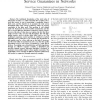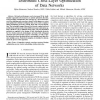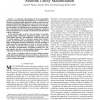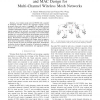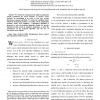CDC
2010
IEEE
14 years 1 months ago
2010
IEEE
Most existing work uses dual decomposition and subgradient methods to solve Network Utility Maximization (NUM) problems in a distributed manner, which suffer from slow rate of con...
CDC
2010
IEEE
14 years 1 months ago
2010
IEEE
We present an on-line crosslayer control technique to characterize and approximate optimal policies for wireless networks. Our approach combines network utility maximization and ad...
GLOBECOM
2010
IEEE
14 years 4 months ago
2010
IEEE
In this paper, we consider the joint problem of congestion control and scheduling with multi-class Quality of Service (QoS) requirements. Generally, the joint problem is formulated...
INFOCOM
2010
IEEE
14 years 5 months ago
2010
IEEE
—The traditional formulation of the total value of information transfer is a multi-commodity flow problem. Here, each data source is seen as generating a commodity along a fixe...
JSAC
2006
14 years 6 months ago
2006
Abstract--Network performance can be increased if the traditionally separated network layers are jointly optimized. Recently, network utility maximization has emerged as a powerful...
JSAC
2006
14 years 6 months ago
2006
Abstract--The current framework of network utility maximization for rate allocation and its price-based algorithms assumes that each link provides a fixed-size transmission "p...
JSAC
2006
14 years 6 months ago
2006
A systematic understanding of the decomposability structures in network utility maximization is key to both resource allocation and functionality allocation. It helps us obtain the...
ECUMN
2007
Springer
15 years 25 days ago
2007
Springer
It is expected that, in near future, the multi-class traffic previously in Public Switched Telephone network (PSTN), cable television network and IP network will be multiplexed at...
INFOCOM
2007
IEEE
15 years 29 days ago
2007
IEEE
— In a wireless mesh network (WMN) with a number of stationary wireless routers, the aggregate capacity can be increased when each router is equipped with multiple network interf...
PIMRC
2008
IEEE
15 years 1 months ago
2008
IEEE
—We extend the existing network utility maximization (NUM) framework for wired networks to wireless sensor networks by formulating it in order to take into account interference a...

